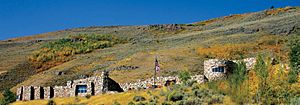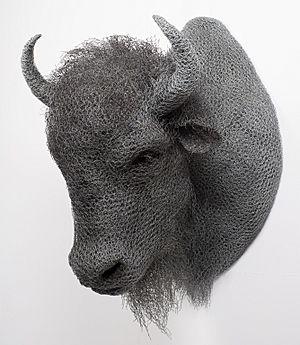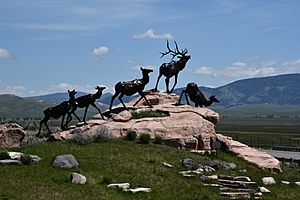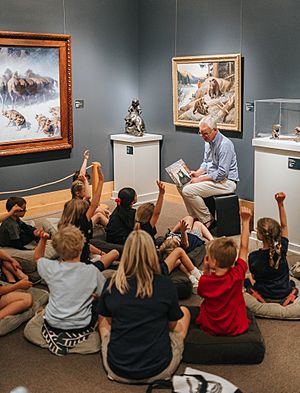National Museum of Wildlife Art facts for kids

The National Museum of Wildlife Art
|
|
| Established | May 16, 1987 |
|---|---|
| Location | 2820 Rungius Road Jackson, Wyoming 83001 United States |
| Type | Wildlife Art |
| Visitors | 85,000+ annually |
The National Museum of Wildlife Art (NMWA) is a special place in Jackson Hole, Wyoming, United States. It's a museum that keeps and shows amazing wildlife art. The museum building is huge, about 51,000 square feet! It's made of a special stone called Idaho quartzite. The way it looks was inspired by old castle ruins in Aberdeenshire, Scotland. It even blends in with the hill behind it.
The museum is built on a hill called East Gros Ventre Butte. This area is a real home for wildlife. From the museum, you can look out over the National Elk Refuge. It's located about 2.5 miles north of the town of Jackson. The art inside the museum mostly shows realistic and modern wildlife scenes. A very important part of the museum's collection includes works by Carl Rungius (1869–1959) and Bob Kuhn (1920–2007).
Besides 14 art galleries, the museum has a sculpture trail outside. There's also a museum shop, a restaurant, and a fun discovery gallery for kids. It even has a library. More than 80,000 people visit the museum every year. Over 10,000 children come to the museum each year, often with their schools. The museum is a nonprofit organization.
Contents
Museum History: How It Started
The National Museum of Wildlife Art was started in 1987. It was founded by William and Joffa Kerr and some of their friends. William Kerr was the son of Robert S. Kerr. The museum first opened in the Jackson Town Square. Back then, it was called the Wildlife of the American West Museum. The Kerr family gave many of their own art pieces to start the museum's collection.
In 1994, the NMWA moved to its current, much larger building. This new building is 51,000 square feet. It's located about 2.5 miles north of the old spot. It sits across Highway 89 from the National Elk Refuge. In September 2007, the museum added a huge new sculpture. It's called Wapiti Trail and shows five elk. It was created by an American artist named Bart Walter.
Amazing Art Collections
As of 2012, the museum had more than 5,000 artworks. These pieces were created by 550 different artists. Besides the famous works by Rungius and Kuhn, you can see art by many other well-known artists. Some examples include Albert Bierstadt, George Catlin, Charles Marion Russell, and Frederic Remington. You can also find art by John James Audubon, N.C. Wyeth, and Robert Bateman.
The collection also features wildlife art by famous artists like Auguste Rodin, Picasso, Rembrandt, and Georgia O'Keeffe. There are also pieces by Andy Warhol and Kendra Haste.
Outdoor Sculpture Trail
The museum has a special Sculpture Trail outside. It was designed by a talented landscape architect named Walter J. Hood. The trail opened in the fall of 2011. It is about three-quarters of a mile long. The trail goes both north and south of the museum building.
When it's fully finished, the trail will have 30 art pieces. Currently, twenty artworks are already placed along the trail. The trail has different paths, bridges, and staircases. These allow you to see the sculptures and the views from many different spots.
The Sculpture Trail is free for everyone to visit. It's close to the main bike path that goes into Jackson. You can get to the Sculpture Trail from the bike path through an underpass. This path also connects to the town of Jackson and Grand Teton National Park.
Learning and Education Programs
The museum offers many educational programs. These programs are designed for different ages and ways of learning. They include both formal classes and fun, informal activities.
The museum also has internship opportunities for college students and recent graduates. These internships are in the Education and Exhibitions Department and the Curatorial Department. They help students learn about working in a museum. The museum also offers other unpaid internships.
Library and Research
The museum has a special library. It's a research library, meaning you can't check out books. It focuses on materials about wildlife art and artists. You can also find books on art history, art care, natural history, and wildlife biology. The library has many different items. These include books, journals, artist biographies, videos, and museum publications. The Library and Archives are open by appointment for people who want to browse, find information, or do research.
Awards and Recognition
In 1994, the National Museum of Wildlife Art received the Wyoming Humanities Award. This award recognized their excellent work in promoting the humanities in Wyoming. On May 8, 2008, President George W. Bush signed a bill. This bill officially recognized the NMWA as the "National Museum of Wildlife Art of the United States."
The Rungius Medal
The Rungius Medal is a very special award. It's named after the famous artist Carl Rungius. The National Museum of Wildlife Art gives this medal to people who have made amazing contributions. These contributions are for showing and protecting wildlife and its natural homes.
By creating the Rungius Medal, the museum honors outstanding people and groups. These can be from fields like fine arts or natural sciences. The Rungius Medal is the highest honor the museum can give.
Some of the people who have won the Rungius Medal include: Joel Sartore (2017), John F. Turner (2010), Bill and Joffa Kerr (2007), and Jane Goodall (2001). Other winners include Robert Bateman (2000), Roger Tory Peterson (1994), and Bob Kuhn (1992).





